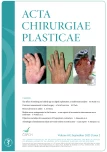Data on paediatric burn mortality from a single centre over 32 years
Authors:
J. Bartková; B. Lipový
Authors place of work:
Department of Burns and Plastic Surgery, University Hospital Brno and Faculty of Medicine, Masaryk University, Brno, Czech Republic
Published in the journal:
ACTA CHIRURGIAE PLASTICAE, 65, 2, 2023, pp. 84-85
Category:
doi:
https://doi.org/10.48095/ccachp202384
Dear Editor,
burn injuries are among the most devastating injuries in general, affecting not only all age groups but also all geographical areas in the world. In addition causing morbidity and mortality, they also have enormous economic, psychological and somatic impacts with long-lasting consequences. Continuous developments in burn treatment have significantly improved burn management and quality of care worldwide [1]. In Europe, the paediatric population still constitutes a high proportion of burn inpatients [2–4].
In this letter, we would like to present the gradual changes in the epidemiological data over the years from a single burn unit, illustrating the continuous improvement of care dedicated to severely burn paediatric patients in the Czech Republic. We analysed the burn injuries-associated paediatric mortality data from the intensive care unit of the Department of Burns and Plastic Surgery University Hospital Brno, Czech Republic, between 1 January 1990 and 31 December 2022. Over the 32 years, 9 paediatric deaths caused by burn injuries were recorded. To better illustrate the evaluation of the observed period, we divided it into 2 periods: the first period from 1990 to 1999 and the second one from 2000 to 2022. During the first period, 7 paediatric patients had fatal burns (5 of them had burns on more than 60% of the total body surface area (TBSA). During the second monitored period, only 2 patients suffered fatal burns, both on more than 60% TBSA. There was a difference in the number of paediatric burn deaths over the years; this number was higher in the 1990s compared to the period after 2000 when only 2 paediatric deaths were recorded. It´s important to realize that most of the fatal burns (77.8%) in both periods were on more than 60% TBSA. In the 1990s the size of the extent of burns, in 5 patients was more than 90% TBSA. Such patients are in direct danger of life and require intensive care in specialized units, which not only emphasizes the severity of their injuries, but also confirms the life-threatening condition for these patients, and thus reduces the possibility of further survival. The majority of these patients died within 1 week of injury (Tab. 1). Multi-organ failure (44.4%) followed by burn shock (33.3%) was the most common cause of death. In a majority of these patients, the condition was further complicated by inhalation injury (55.5%). The male: female ratio in paediatric deaths was 0.8: 1, the differences between sexes are negligible. The average age of paediatric patients who died during the observed period was 8 years. Accidental burning (88.9%) was the most common injury mechanism leading to these deaths in both observed periods. In the presented data, the most common causative agent of burn was flame (55.5%), followed by electrical burns (22.2%). In a minority of patients, chemical burns (11.1%) and scalds (11.1%) were the etiological agents. We attribute that mainly to the superficial nature of scalds not leading to death and also to improved medical care over the period of time. The highest incidence of paediatric burn trauma leading to death was observed in the spring (44.4%), followed by summer (33.3%). The incidence was higher during weekdays (100%) than during weekends (0%), with the maximum on Tuesdays (44.4%).

We attribute mortality data over the last 2 decades mainly to the constantly improving quality of care, but in addition also to the continually improving prevention. Several organizations in the Czech Republic, such as well-known “Popalky”, “Burn fighters”, “Bolí to” and others, are dedicated to the constant education of the public and improving the awareness of the dangers and preventative measures in adults and, especially, the children population. The majority of burn injuries can be prevented. In fact, epidemiological studies and mortality data also serve as an opportunity to raise awareness and improve precautionary programs and strategies.
Disclosure
The authors have no conflicts of interest to disclose. The authors declare that this study has received no financial support. All procedures performed in this study involving human participants were in accordance with ethical standards of the institutional and/or national research committee and with the Helsinki declaration and its later amendments or comparable ethical standards.
Júlia Bartková, MD, MBA
Department of Burns and Plastic
Surgery
University Hospital Brno
Jihlavská 20
625 00 Brno
Czech Republic
e-mail: jul.bartkova@gmail.com
Zdroje
1. Roberts G., Lloyd M., Parker M., et al. The Baux score is dead. Long live the Baux score: a 27-year retrospective cohort study of mortality at a regional burns service. J. Trauma Acute Care Surg. 2012, 72(1): 251–256.
2. Akerlund E., Huss FR., Sjöber F. Burns in Sweden: analysis of 24,538 cases during the period 1987–2004. Burns 2017, 33(1): 31–36.
3. Vloemans AF., Dokter J., van Baar ME., et al. Epidemiology of children admitted to the Dutch burn centres. Changes in referral influence admittance rates in burn centres. Burns 2011, 37(7): 1161–1167.
4. Onarheim H., Jensen SA., Rosenberg BE., et al. The epidemiology of patients with burn injuries admitted to Norwegian hospitals in 2007. Burns 2009, 35(8): 1142–1146.
Štítky
Chirurgia plastická Ortopédia Popáleninová medicína TraumatológiaČlánok vyšiel v časopise
Acta chirurgiae plasticae

2023 Číslo 2
- Metamizol jako analgetikum první volby: kdy, pro koho, jak a proč?
- Fixní kombinace paracetamol/kodein nabízí synergické analgetické účinky
- Antidepresivní efekt kombinovaného analgetika tramadolu s paracetamolem
- Geriatrická křehkost a léčba bolesti
- Kombinace metamizol/paracetamol v léčbě pooperační bolesti u zákroků v rámci jednodenní chirurgie
Najčítanejšie v tomto čísle
- Electrical burns in adults
- Objective and subjective assessment of Dupuytren's contracture
- The effect of smoking and elderly age on digital replantation – a multivariate analysis
- Median nerve entrapments in the forearm – a case report of rare anterior interosseous nerve syndrome
